Commercial Law Case Study: Negligence and Consumer Law Analysis
VerifiedAdded on 2022/11/17
|10
|2806
|198
Case Study
AI Summary
This case study examines the legal issues arising from a product defect and its consequences. Rahul and Priya purchased a baby cot from Baby's R Us. The cot collapsed while their baby, Aaru, was sleeping in it, causing injury and emotional distress. The assignment analyzes whether Rahul and Priya can sue the store for negligence, evaluating the elements of a negligence claim, including duty of care, breach, causation, and damages, considering both physical and psychological harm. The analysis also considers the Australian Consumer Law (ACL), specifically Part 3-5, regarding product liability and consumer rights, including the manufacturer's liability for defective products causing personal injury and other losses. The assignment explores potential claims under the ACL, including statutory guarantees and remedies available to the consumers. The conclusion summarizes the legal positions of Rahul and Priya, considering the relevant laws and potential outcomes.
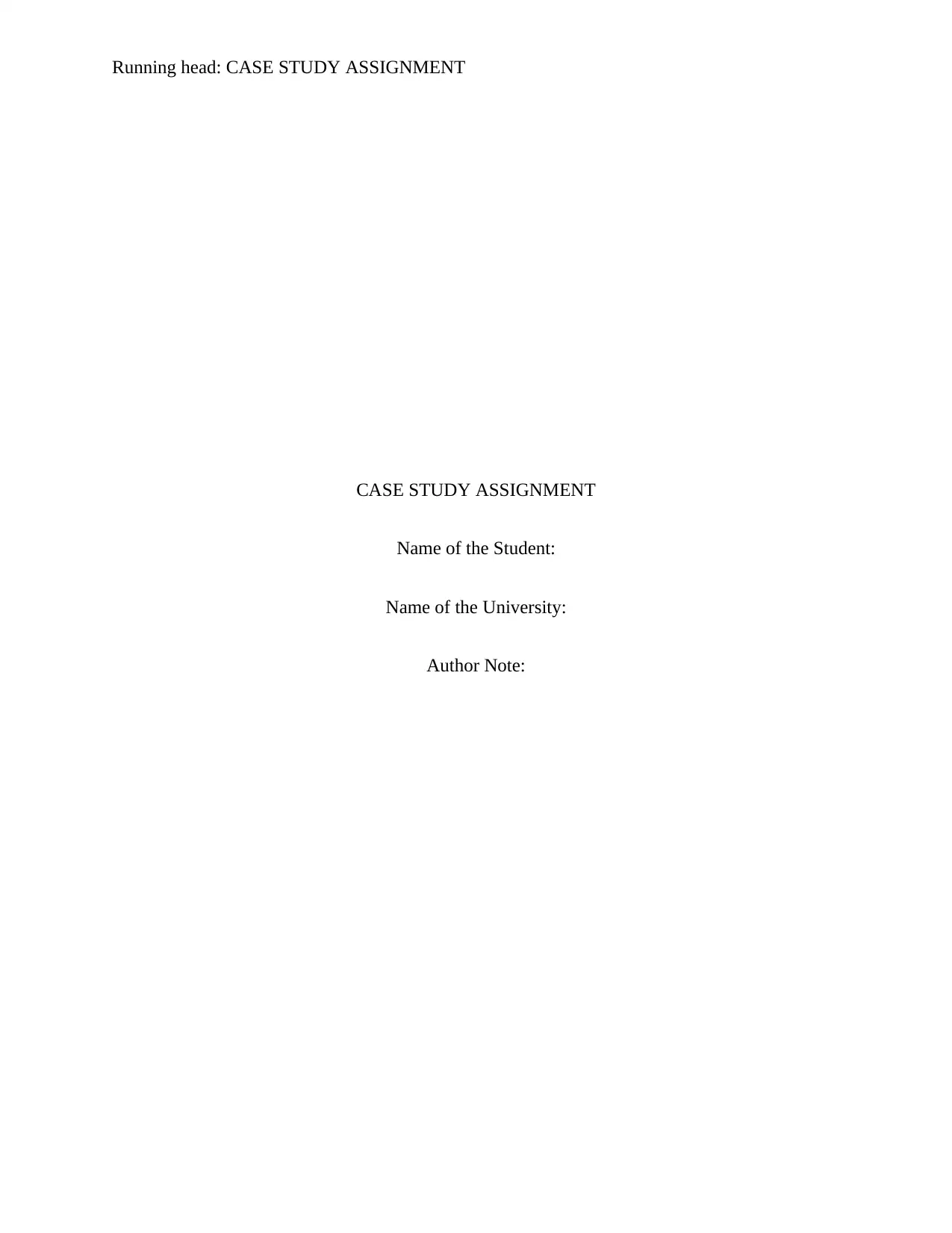
Running head: CASE STUDY ASSIGNMENT
CASE STUDY ASSIGNMENT
Name of the Student:
Name of the University:
Author Note:
CASE STUDY ASSIGNMENT
Name of the Student:
Name of the University:
Author Note:
Paraphrase This Document
Need a fresh take? Get an instant paraphrase of this document with our AI Paraphraser
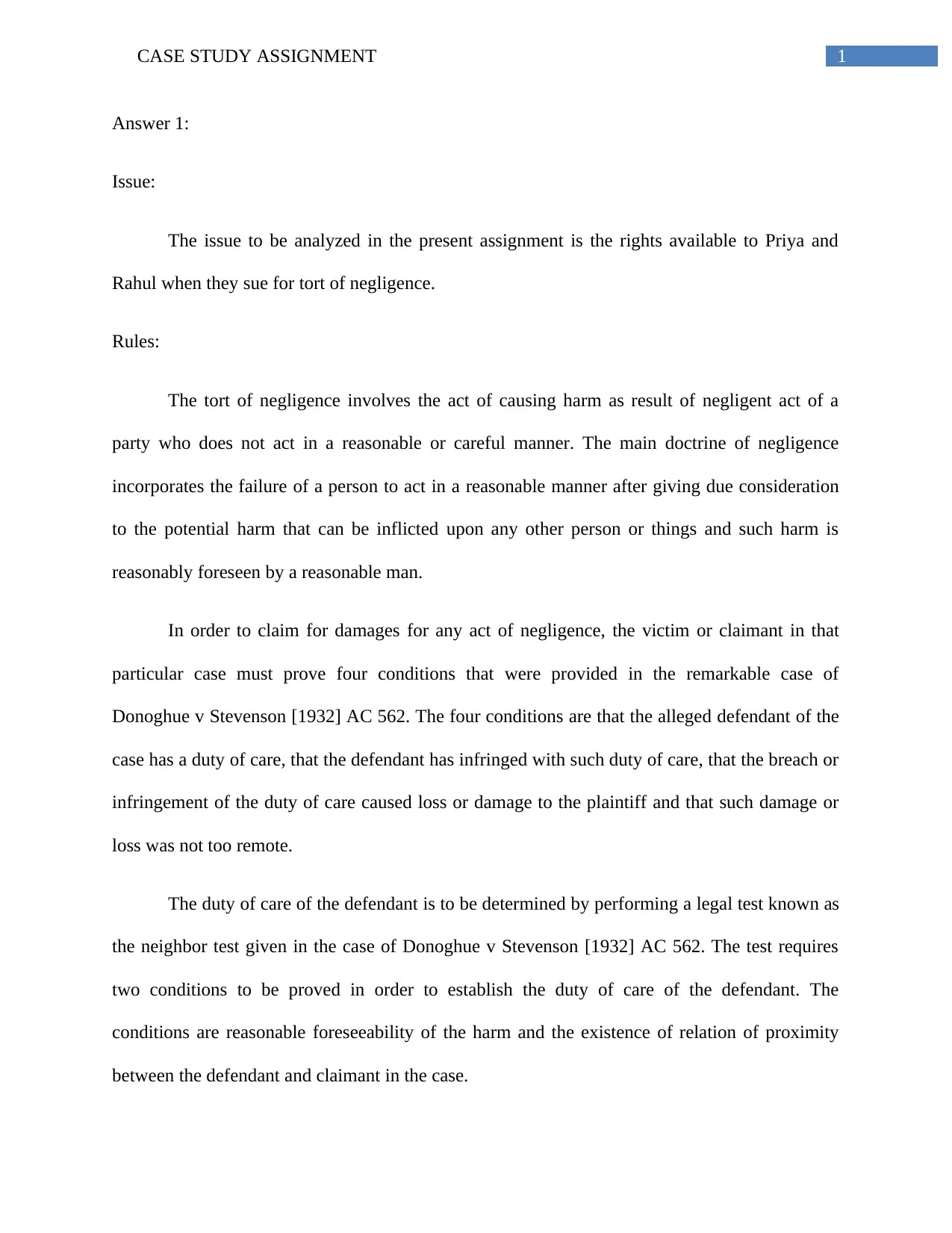
1CASE STUDY ASSIGNMENT
Answer 1:
Issue:
The issue to be analyzed in the present assignment is the rights available to Priya and
Rahul when they sue for tort of negligence.
Rules:
The tort of negligence involves the act of causing harm as result of negligent act of a
party who does not act in a reasonable or careful manner. The main doctrine of negligence
incorporates the failure of a person to act in a reasonable manner after giving due consideration
to the potential harm that can be inflicted upon any other person or things and such harm is
reasonably foreseen by a reasonable man.
In order to claim for damages for any act of negligence, the victim or claimant in that
particular case must prove four conditions that were provided in the remarkable case of
Donoghue v Stevenson [1932] AC 562. The four conditions are that the alleged defendant of the
case has a duty of care, that the defendant has infringed with such duty of care, that the breach or
infringement of the duty of care caused loss or damage to the plaintiff and that such damage or
loss was not too remote.
The duty of care of the defendant is to be determined by performing a legal test known as
the neighbor test given in the case of Donoghue v Stevenson [1932] AC 562. The test requires
two conditions to be proved in order to establish the duty of care of the defendant. The
conditions are reasonable foreseeability of the harm and the existence of relation of proximity
between the defendant and claimant in the case.
Answer 1:
Issue:
The issue to be analyzed in the present assignment is the rights available to Priya and
Rahul when they sue for tort of negligence.
Rules:
The tort of negligence involves the act of causing harm as result of negligent act of a
party who does not act in a reasonable or careful manner. The main doctrine of negligence
incorporates the failure of a person to act in a reasonable manner after giving due consideration
to the potential harm that can be inflicted upon any other person or things and such harm is
reasonably foreseen by a reasonable man.
In order to claim for damages for any act of negligence, the victim or claimant in that
particular case must prove four conditions that were provided in the remarkable case of
Donoghue v Stevenson [1932] AC 562. The four conditions are that the alleged defendant of the
case has a duty of care, that the defendant has infringed with such duty of care, that the breach or
infringement of the duty of care caused loss or damage to the plaintiff and that such damage or
loss was not too remote.
The duty of care of the defendant is to be determined by performing a legal test known as
the neighbor test given in the case of Donoghue v Stevenson [1932] AC 562. The test requires
two conditions to be proved in order to establish the duty of care of the defendant. The
conditions are reasonable foreseeability of the harm and the existence of relation of proximity
between the defendant and claimant in the case.
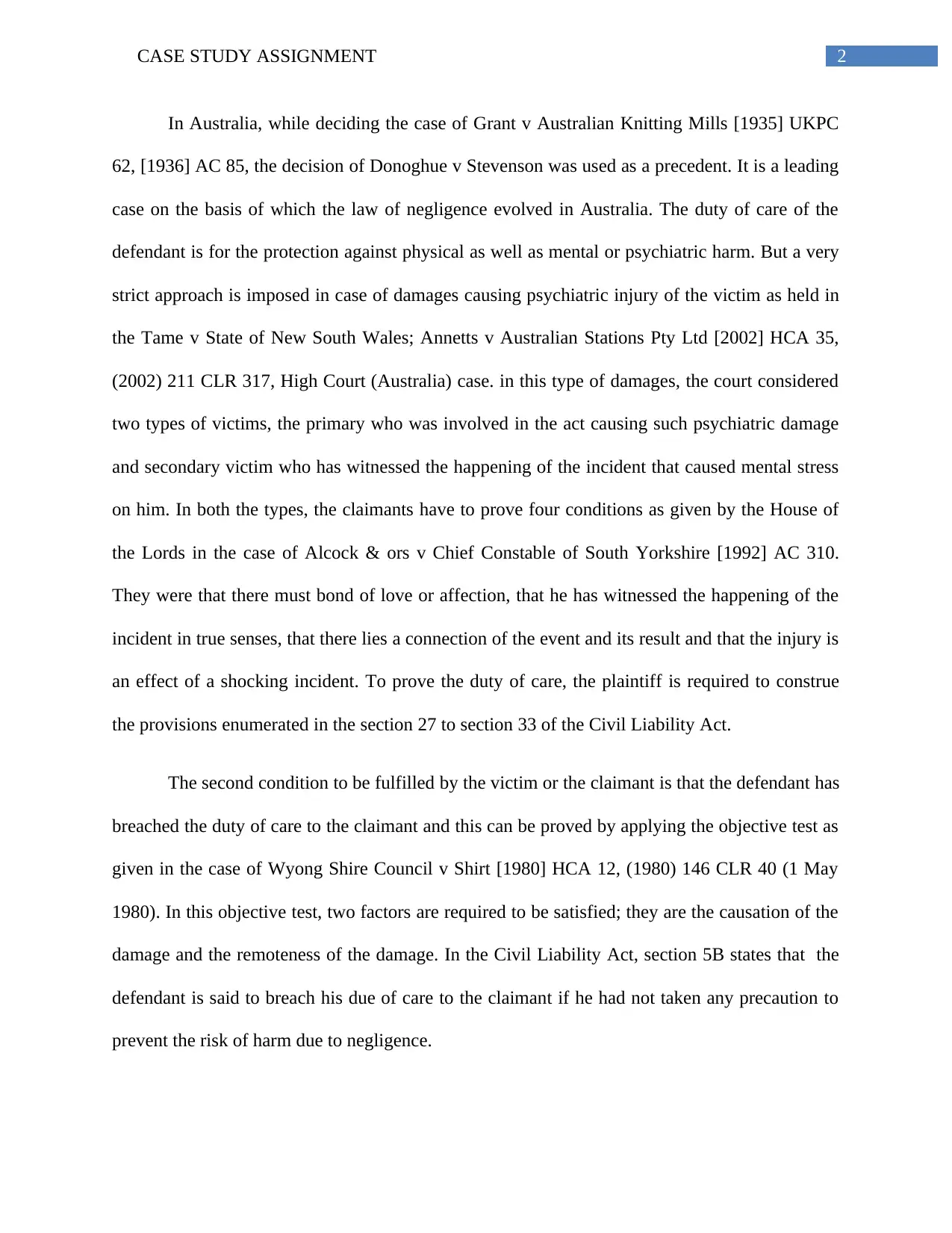
2CASE STUDY ASSIGNMENT
In Australia, while deciding the case of Grant v Australian Knitting Mills [1935] UKPC
62, [1936] AC 85, the decision of Donoghue v Stevenson was used as a precedent. It is a leading
case on the basis of which the law of negligence evolved in Australia. The duty of care of the
defendant is for the protection against physical as well as mental or psychiatric harm. But a very
strict approach is imposed in case of damages causing psychiatric injury of the victim as held in
the Tame v State of New South Wales; Annetts v Australian Stations Pty Ltd [2002] HCA 35,
(2002) 211 CLR 317, High Court (Australia) case. in this type of damages, the court considered
two types of victims, the primary who was involved in the act causing such psychiatric damage
and secondary victim who has witnessed the happening of the incident that caused mental stress
on him. In both the types, the claimants have to prove four conditions as given by the House of
the Lords in the case of Alcock & ors v Chief Constable of South Yorkshire [1992] AC 310.
They were that there must bond of love or affection, that he has witnessed the happening of the
incident in true senses, that there lies a connection of the event and its result and that the injury is
an effect of a shocking incident. To prove the duty of care, the plaintiff is required to construe
the provisions enumerated in the section 27 to section 33 of the Civil Liability Act.
The second condition to be fulfilled by the victim or the claimant is that the defendant has
breached the duty of care to the claimant and this can be proved by applying the objective test as
given in the case of Wyong Shire Council v Shirt [1980] HCA 12, (1980) 146 CLR 40 (1 May
1980). In this objective test, two factors are required to be satisfied; they are the causation of the
damage and the remoteness of the damage. In the Civil Liability Act, section 5B states that the
defendant is said to breach his due of care to the claimant if he had not taken any precaution to
prevent the risk of harm due to negligence.
In Australia, while deciding the case of Grant v Australian Knitting Mills [1935] UKPC
62, [1936] AC 85, the decision of Donoghue v Stevenson was used as a precedent. It is a leading
case on the basis of which the law of negligence evolved in Australia. The duty of care of the
defendant is for the protection against physical as well as mental or psychiatric harm. But a very
strict approach is imposed in case of damages causing psychiatric injury of the victim as held in
the Tame v State of New South Wales; Annetts v Australian Stations Pty Ltd [2002] HCA 35,
(2002) 211 CLR 317, High Court (Australia) case. in this type of damages, the court considered
two types of victims, the primary who was involved in the act causing such psychiatric damage
and secondary victim who has witnessed the happening of the incident that caused mental stress
on him. In both the types, the claimants have to prove four conditions as given by the House of
the Lords in the case of Alcock & ors v Chief Constable of South Yorkshire [1992] AC 310.
They were that there must bond of love or affection, that he has witnessed the happening of the
incident in true senses, that there lies a connection of the event and its result and that the injury is
an effect of a shocking incident. To prove the duty of care, the plaintiff is required to construe
the provisions enumerated in the section 27 to section 33 of the Civil Liability Act.
The second condition to be fulfilled by the victim or the claimant is that the defendant has
breached the duty of care to the claimant and this can be proved by applying the objective test as
given in the case of Wyong Shire Council v Shirt [1980] HCA 12, (1980) 146 CLR 40 (1 May
1980). In this objective test, two factors are required to be satisfied; they are the causation of the
damage and the remoteness of the damage. In the Civil Liability Act, section 5B states that the
defendant is said to breach his due of care to the claimant if he had not taken any precaution to
prevent the risk of harm due to negligence.
⊘ This is a preview!⊘
Do you want full access?
Subscribe today to unlock all pages.

Trusted by 1+ million students worldwide
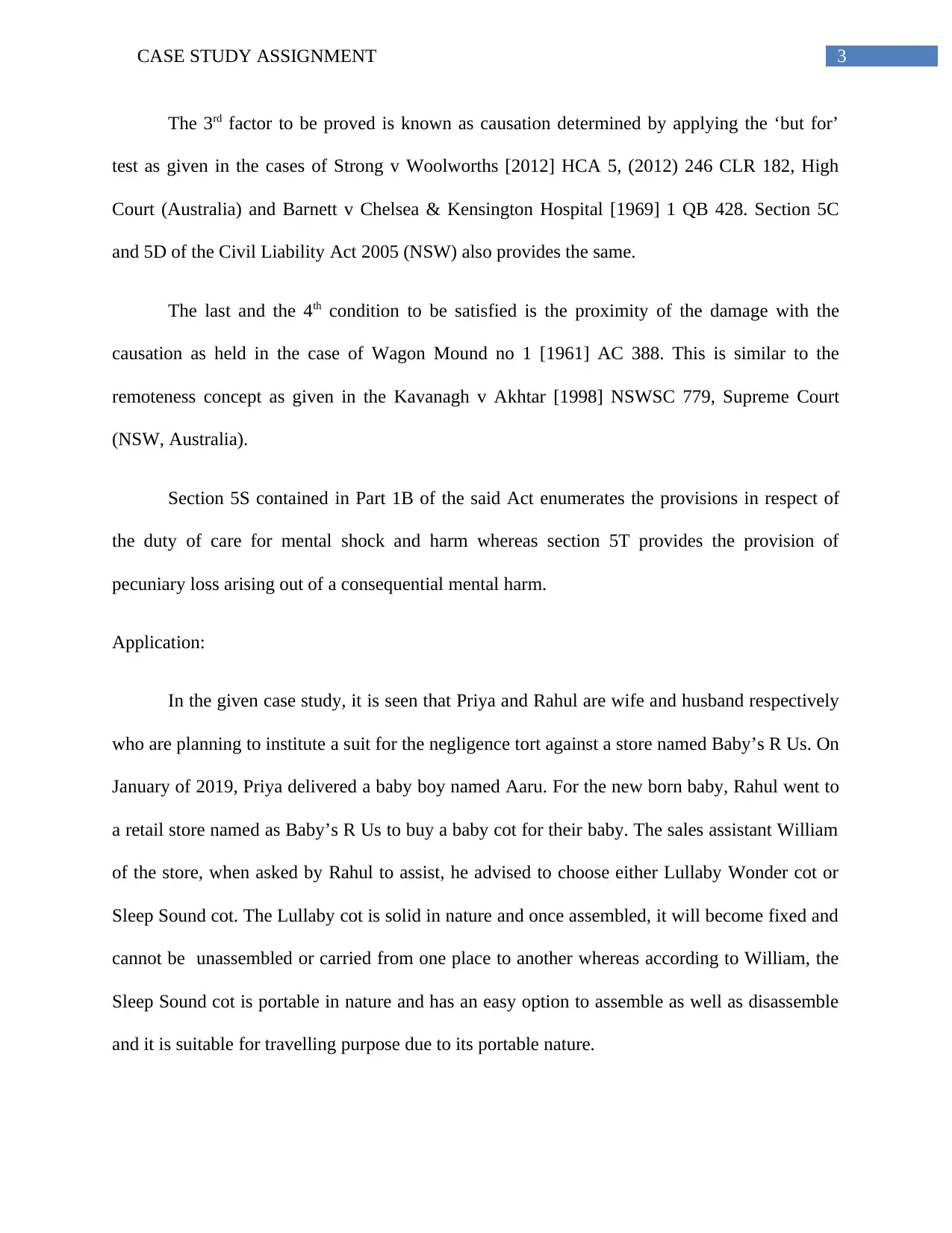
3CASE STUDY ASSIGNMENT
The 3rd factor to be proved is known as causation determined by applying the ‘but for’
test as given in the cases of Strong v Woolworths [2012] HCA 5, (2012) 246 CLR 182, High
Court (Australia) and Barnett v Chelsea & Kensington Hospital [1969] 1 QB 428. Section 5C
and 5D of the Civil Liability Act 2005 (NSW) also provides the same.
The last and the 4th condition to be satisfied is the proximity of the damage with the
causation as held in the case of Wagon Mound no 1 [1961] AC 388. This is similar to the
remoteness concept as given in the Kavanagh v Akhtar [1998] NSWSC 779, Supreme Court
(NSW, Australia).
Section 5S contained in Part 1B of the said Act enumerates the provisions in respect of
the duty of care for mental shock and harm whereas section 5T provides the provision of
pecuniary loss arising out of a consequential mental harm.
Application:
In the given case study, it is seen that Priya and Rahul are wife and husband respectively
who are planning to institute a suit for the negligence tort against a store named Baby’s R Us. On
January of 2019, Priya delivered a baby boy named Aaru. For the new born baby, Rahul went to
a retail store named as Baby’s R Us to buy a baby cot for their baby. The sales assistant William
of the store, when asked by Rahul to assist, he advised to choose either Lullaby Wonder cot or
Sleep Sound cot. The Lullaby cot is solid in nature and once assembled, it will become fixed and
cannot be unassembled or carried from one place to another whereas according to William, the
Sleep Sound cot is portable in nature and has an easy option to assemble as well as disassemble
and it is suitable for travelling purpose due to its portable nature.
The 3rd factor to be proved is known as causation determined by applying the ‘but for’
test as given in the cases of Strong v Woolworths [2012] HCA 5, (2012) 246 CLR 182, High
Court (Australia) and Barnett v Chelsea & Kensington Hospital [1969] 1 QB 428. Section 5C
and 5D of the Civil Liability Act 2005 (NSW) also provides the same.
The last and the 4th condition to be satisfied is the proximity of the damage with the
causation as held in the case of Wagon Mound no 1 [1961] AC 388. This is similar to the
remoteness concept as given in the Kavanagh v Akhtar [1998] NSWSC 779, Supreme Court
(NSW, Australia).
Section 5S contained in Part 1B of the said Act enumerates the provisions in respect of
the duty of care for mental shock and harm whereas section 5T provides the provision of
pecuniary loss arising out of a consequential mental harm.
Application:
In the given case study, it is seen that Priya and Rahul are wife and husband respectively
who are planning to institute a suit for the negligence tort against a store named Baby’s R Us. On
January of 2019, Priya delivered a baby boy named Aaru. For the new born baby, Rahul went to
a retail store named as Baby’s R Us to buy a baby cot for their baby. The sales assistant William
of the store, when asked by Rahul to assist, he advised to choose either Lullaby Wonder cot or
Sleep Sound cot. The Lullaby cot is solid in nature and once assembled, it will become fixed and
cannot be unassembled or carried from one place to another whereas according to William, the
Sleep Sound cot is portable in nature and has an easy option to assemble as well as disassemble
and it is suitable for travelling purpose due to its portable nature.
Paraphrase This Document
Need a fresh take? Get an instant paraphrase of this document with our AI Paraphraser
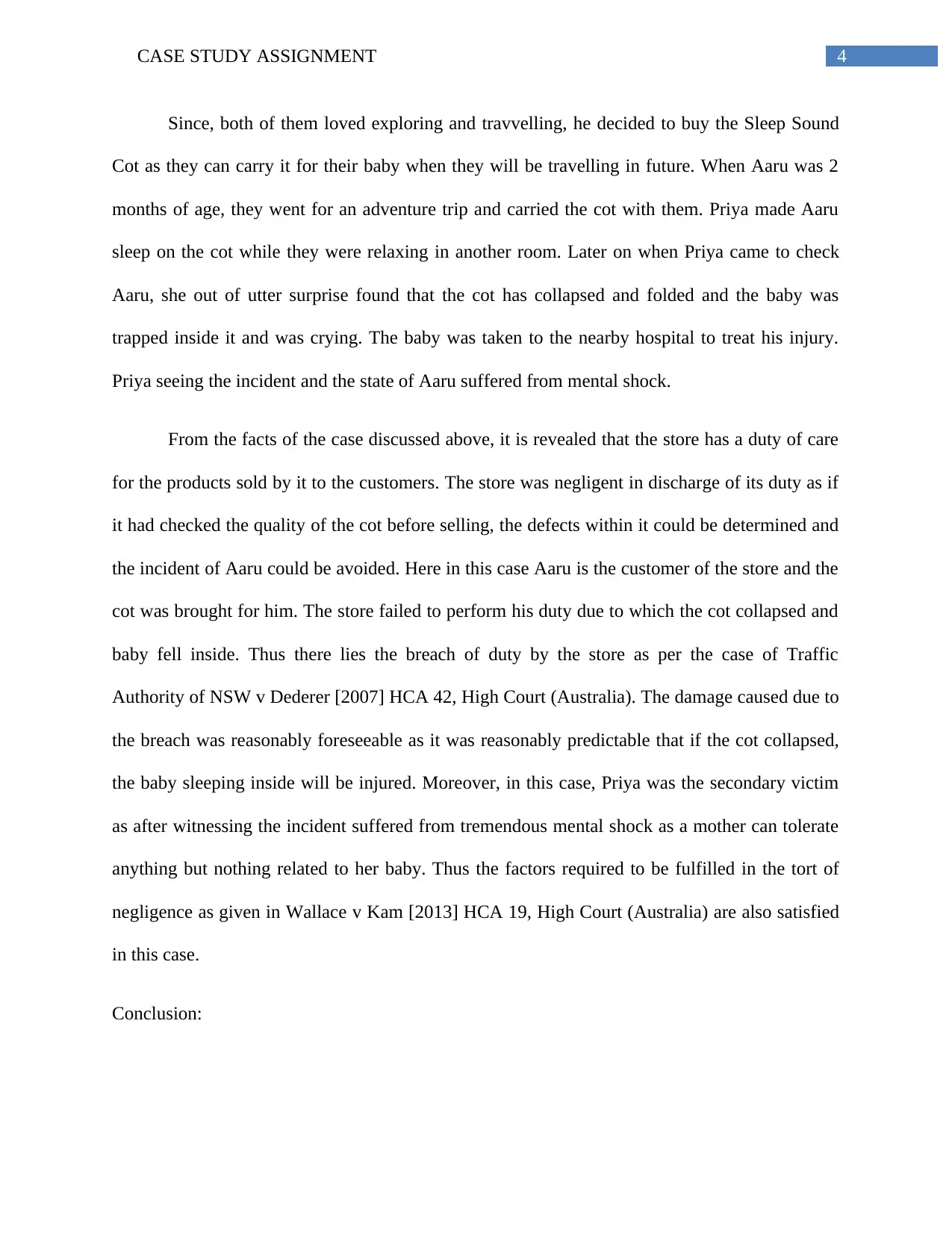
4CASE STUDY ASSIGNMENT
Since, both of them loved exploring and travvelling, he decided to buy the Sleep Sound
Cot as they can carry it for their baby when they will be travelling in future. When Aaru was 2
months of age, they went for an adventure trip and carried the cot with them. Priya made Aaru
sleep on the cot while they were relaxing in another room. Later on when Priya came to check
Aaru, she out of utter surprise found that the cot has collapsed and folded and the baby was
trapped inside it and was crying. The baby was taken to the nearby hospital to treat his injury.
Priya seeing the incident and the state of Aaru suffered from mental shock.
From the facts of the case discussed above, it is revealed that the store has a duty of care
for the products sold by it to the customers. The store was negligent in discharge of its duty as if
it had checked the quality of the cot before selling, the defects within it could be determined and
the incident of Aaru could be avoided. Here in this case Aaru is the customer of the store and the
cot was brought for him. The store failed to perform his duty due to which the cot collapsed and
baby fell inside. Thus there lies the breach of duty by the store as per the case of Traffic
Authority of NSW v Dederer [2007] HCA 42, High Court (Australia). The damage caused due to
the breach was reasonably foreseeable as it was reasonably predictable that if the cot collapsed,
the baby sleeping inside will be injured. Moreover, in this case, Priya was the secondary victim
as after witnessing the incident suffered from tremendous mental shock as a mother can tolerate
anything but nothing related to her baby. Thus the factors required to be fulfilled in the tort of
negligence as given in Wallace v Kam [2013] HCA 19, High Court (Australia) are also satisfied
in this case.
Conclusion:
Since, both of them loved exploring and travvelling, he decided to buy the Sleep Sound
Cot as they can carry it for their baby when they will be travelling in future. When Aaru was 2
months of age, they went for an adventure trip and carried the cot with them. Priya made Aaru
sleep on the cot while they were relaxing in another room. Later on when Priya came to check
Aaru, she out of utter surprise found that the cot has collapsed and folded and the baby was
trapped inside it and was crying. The baby was taken to the nearby hospital to treat his injury.
Priya seeing the incident and the state of Aaru suffered from mental shock.
From the facts of the case discussed above, it is revealed that the store has a duty of care
for the products sold by it to the customers. The store was negligent in discharge of its duty as if
it had checked the quality of the cot before selling, the defects within it could be determined and
the incident of Aaru could be avoided. Here in this case Aaru is the customer of the store and the
cot was brought for him. The store failed to perform his duty due to which the cot collapsed and
baby fell inside. Thus there lies the breach of duty by the store as per the case of Traffic
Authority of NSW v Dederer [2007] HCA 42, High Court (Australia). The damage caused due to
the breach was reasonably foreseeable as it was reasonably predictable that if the cot collapsed,
the baby sleeping inside will be injured. Moreover, in this case, Priya was the secondary victim
as after witnessing the incident suffered from tremendous mental shock as a mother can tolerate
anything but nothing related to her baby. Thus the factors required to be fulfilled in the tort of
negligence as given in Wallace v Kam [2013] HCA 19, High Court (Australia) are also satisfied
in this case.
Conclusion:
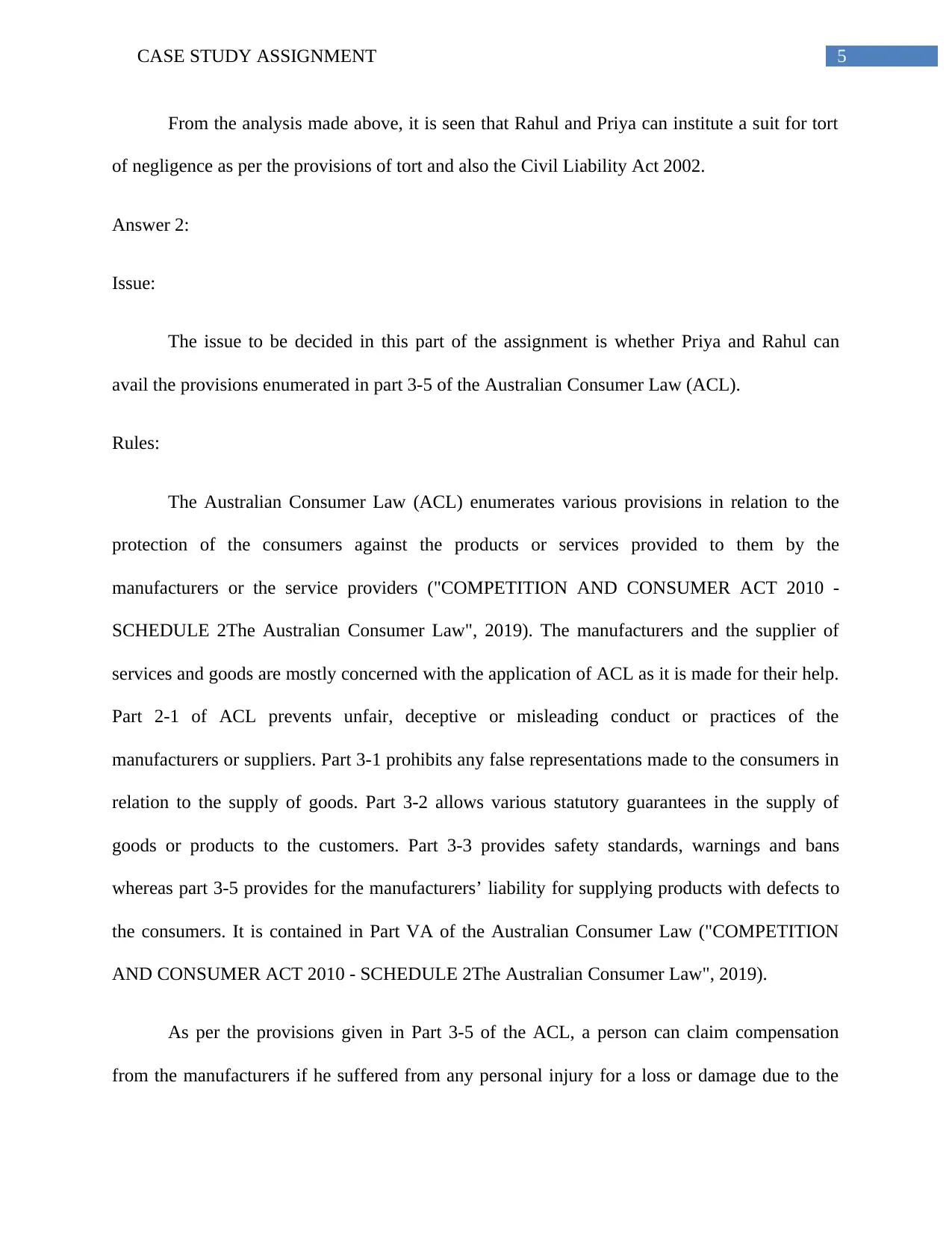
5CASE STUDY ASSIGNMENT
From the analysis made above, it is seen that Rahul and Priya can institute a suit for tort
of negligence as per the provisions of tort and also the Civil Liability Act 2002.
Answer 2:
Issue:
The issue to be decided in this part of the assignment is whether Priya and Rahul can
avail the provisions enumerated in part 3-5 of the Australian Consumer Law (ACL).
Rules:
The Australian Consumer Law (ACL) enumerates various provisions in relation to the
protection of the consumers against the products or services provided to them by the
manufacturers or the service providers ("COMPETITION AND CONSUMER ACT 2010 -
SCHEDULE 2The Australian Consumer Law", 2019). The manufacturers and the supplier of
services and goods are mostly concerned with the application of ACL as it is made for their help.
Part 2-1 of ACL prevents unfair, deceptive or misleading conduct or practices of the
manufacturers or suppliers. Part 3-1 prohibits any false representations made to the consumers in
relation to the supply of goods. Part 3-2 allows various statutory guarantees in the supply of
goods or products to the customers. Part 3-3 provides safety standards, warnings and bans
whereas part 3-5 provides for the manufacturers’ liability for supplying products with defects to
the consumers. It is contained in Part VA of the Australian Consumer Law ("COMPETITION
AND CONSUMER ACT 2010 - SCHEDULE 2The Australian Consumer Law", 2019).
As per the provisions given in Part 3-5 of the ACL, a person can claim compensation
from the manufacturers if he suffered from any personal injury for a loss or damage due to the
From the analysis made above, it is seen that Rahul and Priya can institute a suit for tort
of negligence as per the provisions of tort and also the Civil Liability Act 2002.
Answer 2:
Issue:
The issue to be decided in this part of the assignment is whether Priya and Rahul can
avail the provisions enumerated in part 3-5 of the Australian Consumer Law (ACL).
Rules:
The Australian Consumer Law (ACL) enumerates various provisions in relation to the
protection of the consumers against the products or services provided to them by the
manufacturers or the service providers ("COMPETITION AND CONSUMER ACT 2010 -
SCHEDULE 2The Australian Consumer Law", 2019). The manufacturers and the supplier of
services and goods are mostly concerned with the application of ACL as it is made for their help.
Part 2-1 of ACL prevents unfair, deceptive or misleading conduct or practices of the
manufacturers or suppliers. Part 3-1 prohibits any false representations made to the consumers in
relation to the supply of goods. Part 3-2 allows various statutory guarantees in the supply of
goods or products to the customers. Part 3-3 provides safety standards, warnings and bans
whereas part 3-5 provides for the manufacturers’ liability for supplying products with defects to
the consumers. It is contained in Part VA of the Australian Consumer Law ("COMPETITION
AND CONSUMER ACT 2010 - SCHEDULE 2The Australian Consumer Law", 2019).
As per the provisions given in Part 3-5 of the ACL, a person can claim compensation
from the manufacturers if he suffered from any personal injury for a loss or damage due to the
⊘ This is a preview!⊘
Do you want full access?
Subscribe today to unlock all pages.

Trusted by 1+ million students worldwide
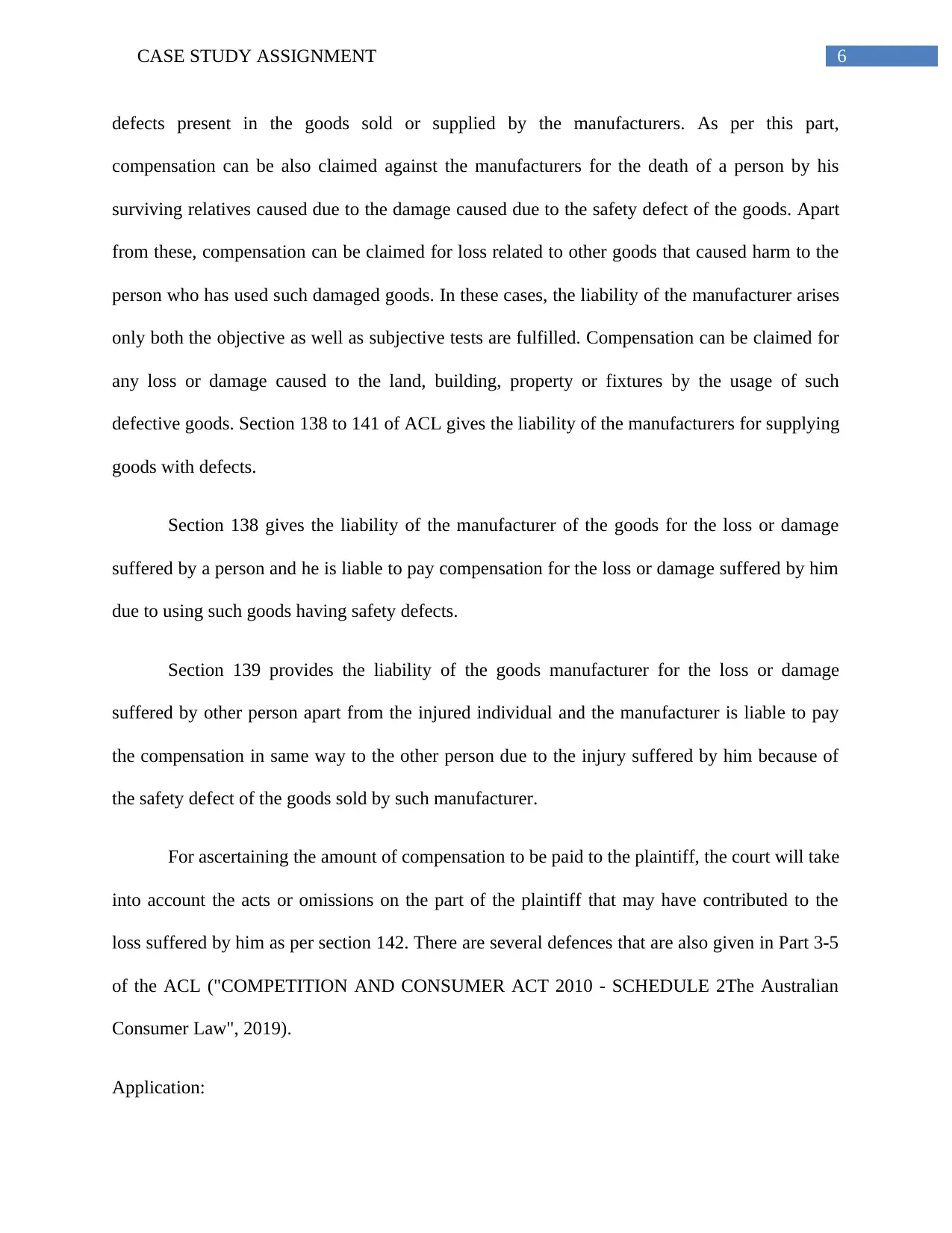
6CASE STUDY ASSIGNMENT
defects present in the goods sold or supplied by the manufacturers. As per this part,
compensation can be also claimed against the manufacturers for the death of a person by his
surviving relatives caused due to the damage caused due to the safety defect of the goods. Apart
from these, compensation can be claimed for loss related to other goods that caused harm to the
person who has used such damaged goods. In these cases, the liability of the manufacturer arises
only both the objective as well as subjective tests are fulfilled. Compensation can be claimed for
any loss or damage caused to the land, building, property or fixtures by the usage of such
defective goods. Section 138 to 141 of ACL gives the liability of the manufacturers for supplying
goods with defects.
Section 138 gives the liability of the manufacturer of the goods for the loss or damage
suffered by a person and he is liable to pay compensation for the loss or damage suffered by him
due to using such goods having safety defects.
Section 139 provides the liability of the goods manufacturer for the loss or damage
suffered by other person apart from the injured individual and the manufacturer is liable to pay
the compensation in same way to the other person due to the injury suffered by him because of
the safety defect of the goods sold by such manufacturer.
For ascertaining the amount of compensation to be paid to the plaintiff, the court will take
into account the acts or omissions on the part of the plaintiff that may have contributed to the
loss suffered by him as per section 142. There are several defences that are also given in Part 3-5
of the ACL ("COMPETITION AND CONSUMER ACT 2010 - SCHEDULE 2The Australian
Consumer Law", 2019).
Application:
defects present in the goods sold or supplied by the manufacturers. As per this part,
compensation can be also claimed against the manufacturers for the death of a person by his
surviving relatives caused due to the damage caused due to the safety defect of the goods. Apart
from these, compensation can be claimed for loss related to other goods that caused harm to the
person who has used such damaged goods. In these cases, the liability of the manufacturer arises
only both the objective as well as subjective tests are fulfilled. Compensation can be claimed for
any loss or damage caused to the land, building, property or fixtures by the usage of such
defective goods. Section 138 to 141 of ACL gives the liability of the manufacturers for supplying
goods with defects.
Section 138 gives the liability of the manufacturer of the goods for the loss or damage
suffered by a person and he is liable to pay compensation for the loss or damage suffered by him
due to using such goods having safety defects.
Section 139 provides the liability of the goods manufacturer for the loss or damage
suffered by other person apart from the injured individual and the manufacturer is liable to pay
the compensation in same way to the other person due to the injury suffered by him because of
the safety defect of the goods sold by such manufacturer.
For ascertaining the amount of compensation to be paid to the plaintiff, the court will take
into account the acts or omissions on the part of the plaintiff that may have contributed to the
loss suffered by him as per section 142. There are several defences that are also given in Part 3-5
of the ACL ("COMPETITION AND CONSUMER ACT 2010 - SCHEDULE 2The Australian
Consumer Law", 2019).
Application:
Paraphrase This Document
Need a fresh take? Get an instant paraphrase of this document with our AI Paraphraser
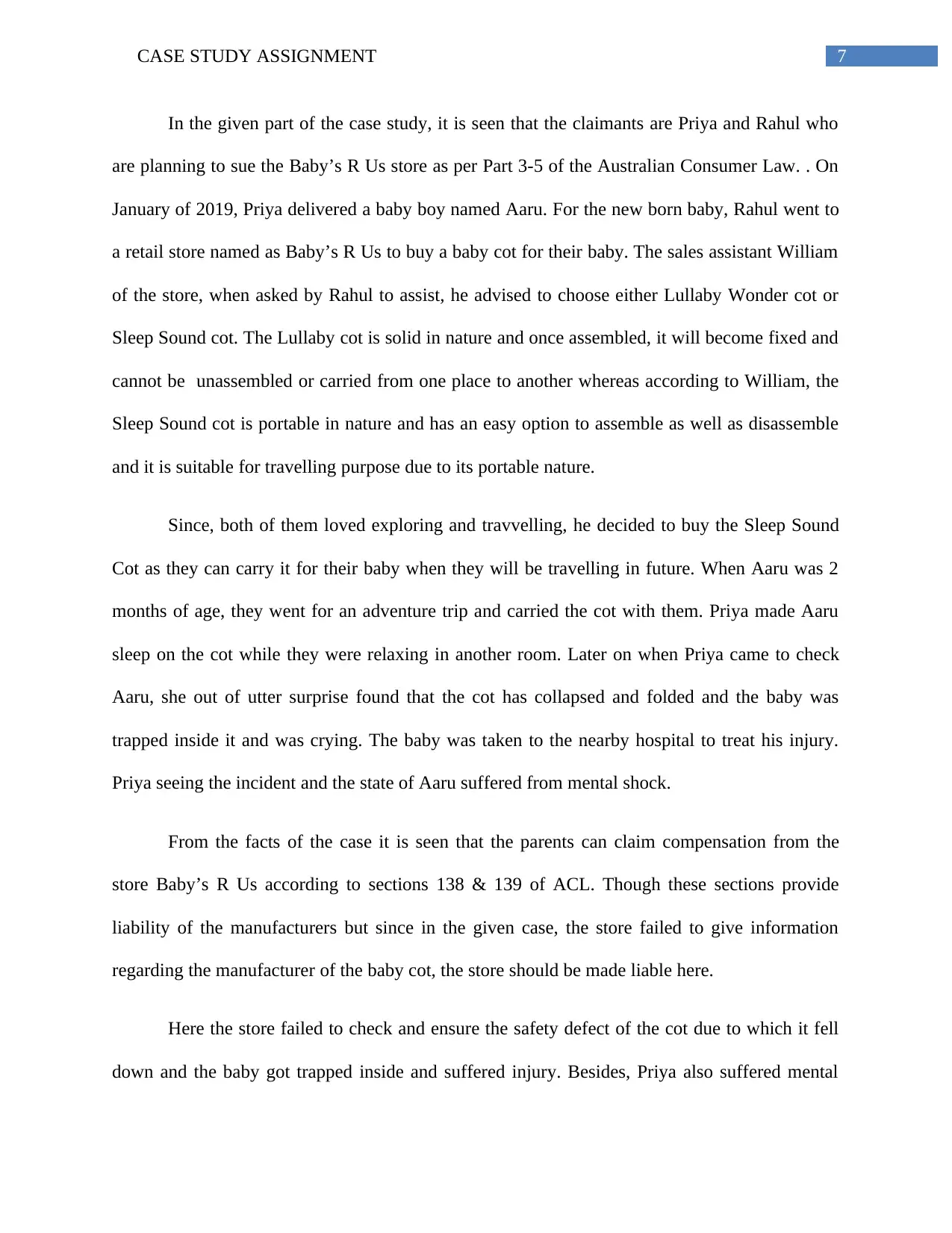
7CASE STUDY ASSIGNMENT
In the given part of the case study, it is seen that the claimants are Priya and Rahul who
are planning to sue the Baby’s R Us store as per Part 3-5 of the Australian Consumer Law. . On
January of 2019, Priya delivered a baby boy named Aaru. For the new born baby, Rahul went to
a retail store named as Baby’s R Us to buy a baby cot for their baby. The sales assistant William
of the store, when asked by Rahul to assist, he advised to choose either Lullaby Wonder cot or
Sleep Sound cot. The Lullaby cot is solid in nature and once assembled, it will become fixed and
cannot be unassembled or carried from one place to another whereas according to William, the
Sleep Sound cot is portable in nature and has an easy option to assemble as well as disassemble
and it is suitable for travelling purpose due to its portable nature.
Since, both of them loved exploring and travvelling, he decided to buy the Sleep Sound
Cot as they can carry it for their baby when they will be travelling in future. When Aaru was 2
months of age, they went for an adventure trip and carried the cot with them. Priya made Aaru
sleep on the cot while they were relaxing in another room. Later on when Priya came to check
Aaru, she out of utter surprise found that the cot has collapsed and folded and the baby was
trapped inside it and was crying. The baby was taken to the nearby hospital to treat his injury.
Priya seeing the incident and the state of Aaru suffered from mental shock.
From the facts of the case it is seen that the parents can claim compensation from the
store Baby’s R Us according to sections 138 & 139 of ACL. Though these sections provide
liability of the manufacturers but since in the given case, the store failed to give information
regarding the manufacturer of the baby cot, the store should be made liable here.
Here the store failed to check and ensure the safety defect of the cot due to which it fell
down and the baby got trapped inside and suffered injury. Besides, Priya also suffered mental
In the given part of the case study, it is seen that the claimants are Priya and Rahul who
are planning to sue the Baby’s R Us store as per Part 3-5 of the Australian Consumer Law. . On
January of 2019, Priya delivered a baby boy named Aaru. For the new born baby, Rahul went to
a retail store named as Baby’s R Us to buy a baby cot for their baby. The sales assistant William
of the store, when asked by Rahul to assist, he advised to choose either Lullaby Wonder cot or
Sleep Sound cot. The Lullaby cot is solid in nature and once assembled, it will become fixed and
cannot be unassembled or carried from one place to another whereas according to William, the
Sleep Sound cot is portable in nature and has an easy option to assemble as well as disassemble
and it is suitable for travelling purpose due to its portable nature.
Since, both of them loved exploring and travvelling, he decided to buy the Sleep Sound
Cot as they can carry it for their baby when they will be travelling in future. When Aaru was 2
months of age, they went for an adventure trip and carried the cot with them. Priya made Aaru
sleep on the cot while they were relaxing in another room. Later on when Priya came to check
Aaru, she out of utter surprise found that the cot has collapsed and folded and the baby was
trapped inside it and was crying. The baby was taken to the nearby hospital to treat his injury.
Priya seeing the incident and the state of Aaru suffered from mental shock.
From the facts of the case it is seen that the parents can claim compensation from the
store Baby’s R Us according to sections 138 & 139 of ACL. Though these sections provide
liability of the manufacturers but since in the given case, the store failed to give information
regarding the manufacturer of the baby cot, the store should be made liable here.
Here the store failed to check and ensure the safety defect of the cot due to which it fell
down and the baby got trapped inside and suffered injury. Besides, Priya also suffered mental
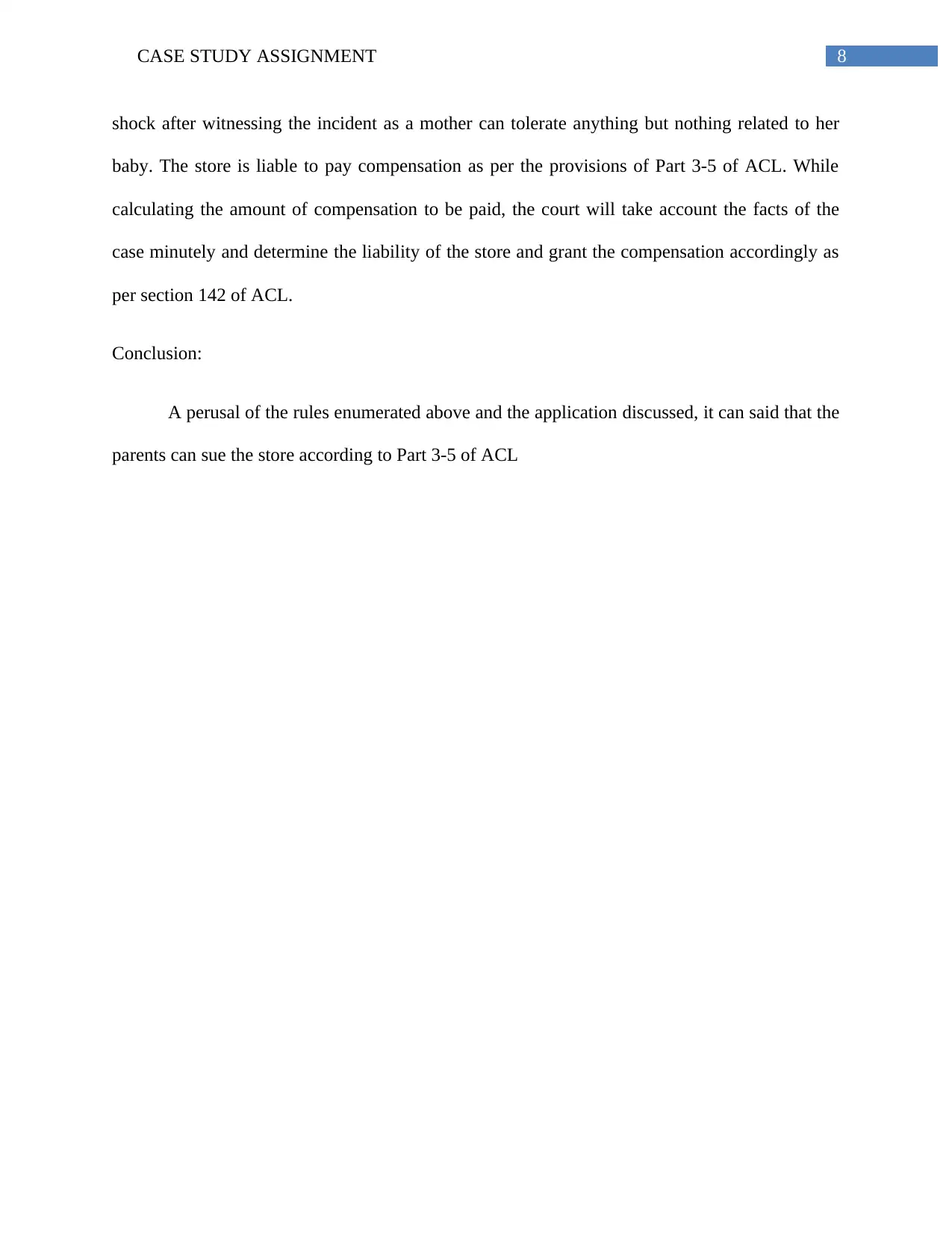
8CASE STUDY ASSIGNMENT
shock after witnessing the incident as a mother can tolerate anything but nothing related to her
baby. The store is liable to pay compensation as per the provisions of Part 3-5 of ACL. While
calculating the amount of compensation to be paid, the court will take account the facts of the
case minutely and determine the liability of the store and grant the compensation accordingly as
per section 142 of ACL.
Conclusion:
A perusal of the rules enumerated above and the application discussed, it can said that the
parents can sue the store according to Part 3-5 of ACL
shock after witnessing the incident as a mother can tolerate anything but nothing related to her
baby. The store is liable to pay compensation as per the provisions of Part 3-5 of ACL. While
calculating the amount of compensation to be paid, the court will take account the facts of the
case minutely and determine the liability of the store and grant the compensation accordingly as
per section 142 of ACL.
Conclusion:
A perusal of the rules enumerated above and the application discussed, it can said that the
parents can sue the store according to Part 3-5 of ACL
⊘ This is a preview!⊘
Do you want full access?
Subscribe today to unlock all pages.

Trusted by 1+ million students worldwide
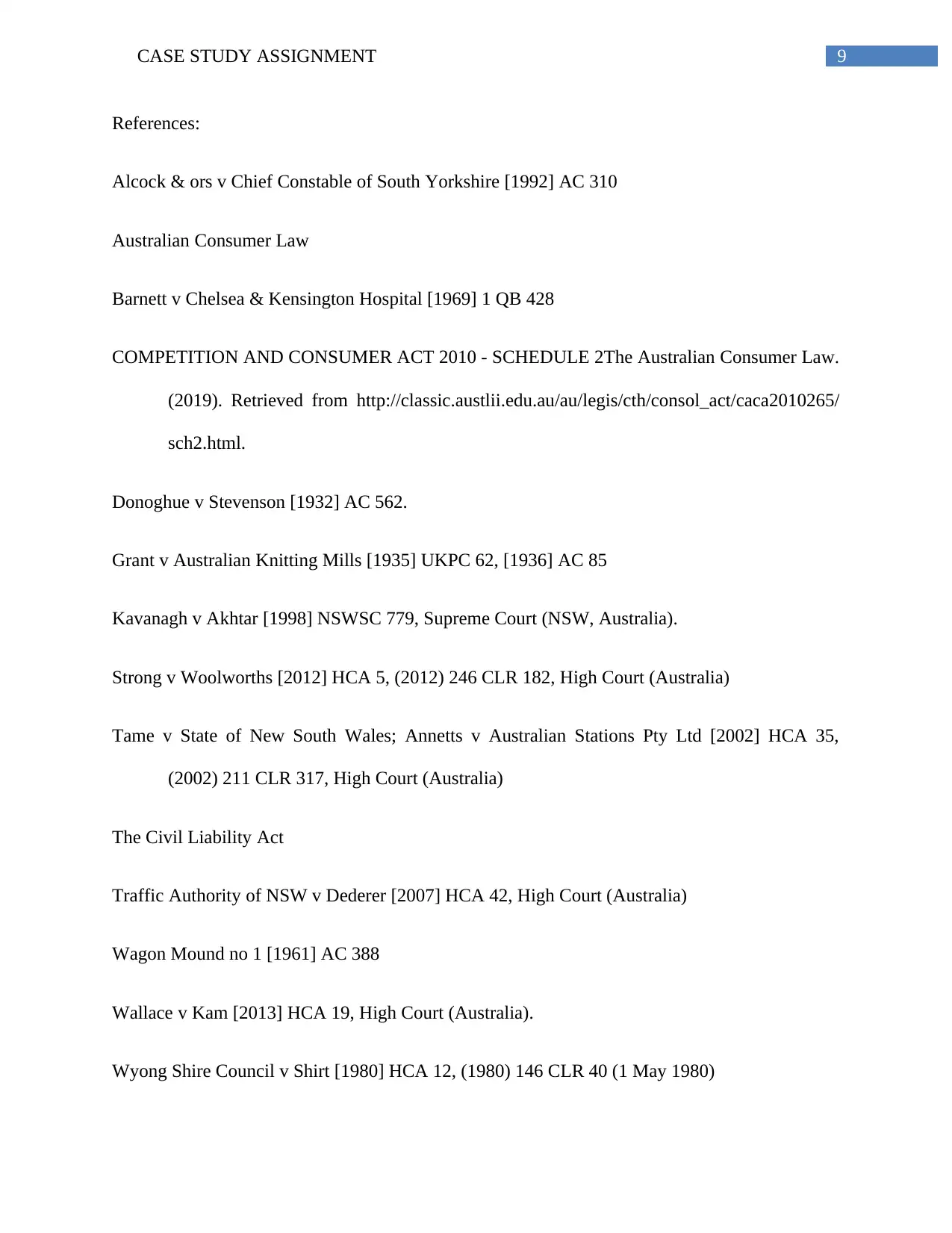
9CASE STUDY ASSIGNMENT
References:
Alcock & ors v Chief Constable of South Yorkshire [1992] AC 310
Australian Consumer Law
Barnett v Chelsea & Kensington Hospital [1969] 1 QB 428
COMPETITION AND CONSUMER ACT 2010 - SCHEDULE 2The Australian Consumer Law.
(2019). Retrieved from http://classic.austlii.edu.au/au/legis/cth/consol_act/caca2010265/
sch2.html.
Donoghue v Stevenson [1932] AC 562.
Grant v Australian Knitting Mills [1935] UKPC 62, [1936] AC 85
Kavanagh v Akhtar [1998] NSWSC 779, Supreme Court (NSW, Australia).
Strong v Woolworths [2012] HCA 5, (2012) 246 CLR 182, High Court (Australia)
Tame v State of New South Wales; Annetts v Australian Stations Pty Ltd [2002] HCA 35,
(2002) 211 CLR 317, High Court (Australia)
The Civil Liability Act
Traffic Authority of NSW v Dederer [2007] HCA 42, High Court (Australia)
Wagon Mound no 1 [1961] AC 388
Wallace v Kam [2013] HCA 19, High Court (Australia).
Wyong Shire Council v Shirt [1980] HCA 12, (1980) 146 CLR 40 (1 May 1980)
References:
Alcock & ors v Chief Constable of South Yorkshire [1992] AC 310
Australian Consumer Law
Barnett v Chelsea & Kensington Hospital [1969] 1 QB 428
COMPETITION AND CONSUMER ACT 2010 - SCHEDULE 2The Australian Consumer Law.
(2019). Retrieved from http://classic.austlii.edu.au/au/legis/cth/consol_act/caca2010265/
sch2.html.
Donoghue v Stevenson [1932] AC 562.
Grant v Australian Knitting Mills [1935] UKPC 62, [1936] AC 85
Kavanagh v Akhtar [1998] NSWSC 779, Supreme Court (NSW, Australia).
Strong v Woolworths [2012] HCA 5, (2012) 246 CLR 182, High Court (Australia)
Tame v State of New South Wales; Annetts v Australian Stations Pty Ltd [2002] HCA 35,
(2002) 211 CLR 317, High Court (Australia)
The Civil Liability Act
Traffic Authority of NSW v Dederer [2007] HCA 42, High Court (Australia)
Wagon Mound no 1 [1961] AC 388
Wallace v Kam [2013] HCA 19, High Court (Australia).
Wyong Shire Council v Shirt [1980] HCA 12, (1980) 146 CLR 40 (1 May 1980)
1 out of 10
Related Documents
Your All-in-One AI-Powered Toolkit for Academic Success.
+13062052269
info@desklib.com
Available 24*7 on WhatsApp / Email
![[object Object]](/_next/static/media/star-bottom.7253800d.svg)
Unlock your academic potential
Copyright © 2020–2025 A2Z Services. All Rights Reserved. Developed and managed by ZUCOL.





